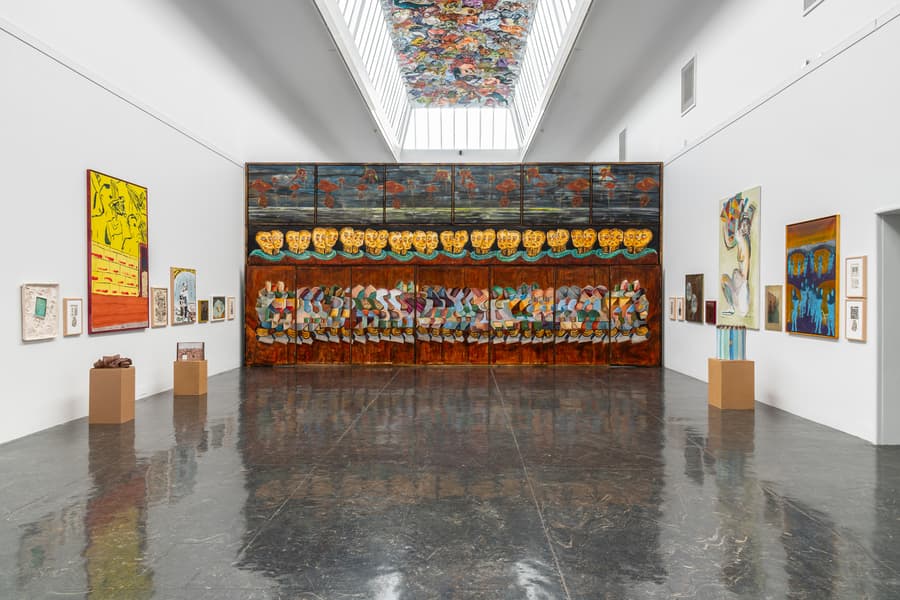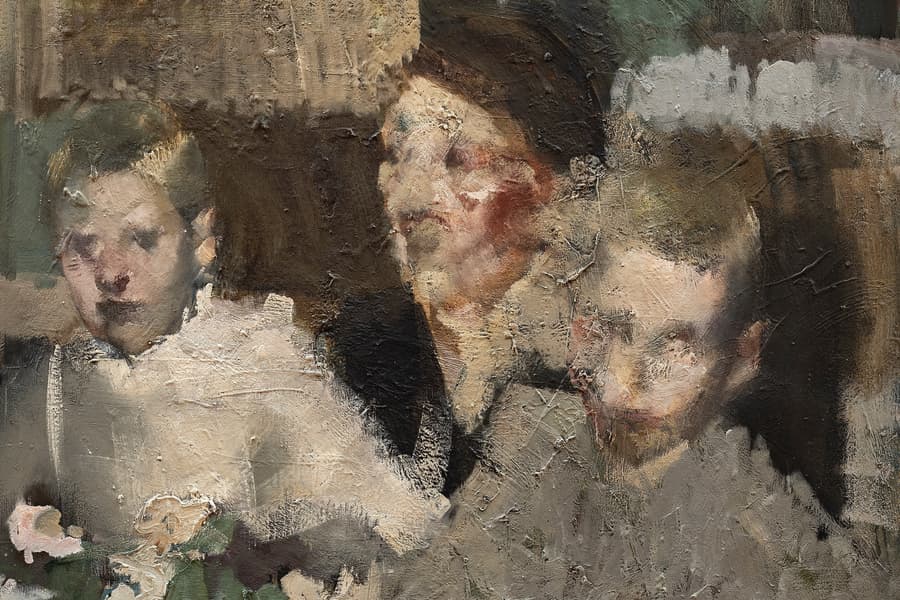Belgian Art

Belgian Art - painting, etching, drawing and sculpture
About the exhibition
This exhibition shows the works of the members of the association L'Art Contemporain in Antwerp, the most famous painters and sculptors from Belgium in the 30s. The exhibition shows the different sides of Belgium's modern art, with a spotlight on the country's "development from the triumphs of impressionism in reaction to academic realism."
Artists
James Ensor, Jacob Smits, Constantin Meunier, Eugène Laermans, Victor Hageman, Alfred Delaunois, Richard Baseleer, Walter Vaes, Jules de Bruycker, Maurice Wagemans, Eugène van Mieghem, Rick Wousters, Marcel Jefferys, Auguste Oleffe, Georges Morren, Wilhelm Paerels, Ferdinand Schirren, Henri Ramah, Albert Servaes, Gustave van de Woestyne, Constant Permeke, Fritz van den Berghe, Edgar Tytgat, Jean Brusselmans, Floris Jespers, Hyppolyte Daeye, Louis Thevenet, Georges Minne, Ernest Wynants, Oscar Jespers.
Om kunstnerne
Excerpt from the catalogue:
"Among the first to be mentioned is James Ensor (b. Ostend 1860). A wizard of light, a poetic mocker, a musician who confuses and a sharp satirist, he bears the greatest name in modern Belgian art. His works became the definitive sign of liberation from fin de siêcle art. In their magnificent overview 'Flandre', Luc and Paul Haessarts have rightly stated that Ensor's painting is a synthesis of all modern art.
The great influence of this painter does not, however, make one forget another less famous but in many ways similar master. Ensor, Jacob Smits (Rotterdam 1856 - Moll 1928). Underestimated and persecuted as an artist, he became a passionate portrayer of light. He would certainly have left behind a huge output if he had not, morbidly self-critical, often destroyed his work in despair. His art has not yet reached full appreciation, but the name Smits will certainly in the future have the same good reputation as Ensor's. Smits was not really an impressionist in that sense, but rather approached realism like Eugène Laermans, Victor Hageman and Constantin Meunier. But the reality he depicted was a transposed reality and by a strong simplification he was a precursor of expressionism.
Constantin Meunier (Brussels 1831-1905) is best known mainly as a sculptor and was a pupil of Rodin. But he was also an exceptionally gifted painter of overwhelming power and intensity.
Eugene Laermans (b. Brussels 1864) also began as a realist and became best known as the painter of the Flemish peasant, the creator of simple and grandiose scenes.
Victor Hageman was also a realist. He did not become the pioneer one would have expected from the outset, but he is nevertheless among the first of his time.
(...)
Alfred Delaunois (Brussels 1876), Constantin Meunier's pupil and friend, stands between realism and the new guidelines of modern art. In recent years, however, he has achieved greater freedom in rendering his favorite subject, church interiors.
Richard Baseleer (Antwerp 1867) is a painter of great feeling and a distinguished elegance of his own. He is considered, alongside his friend Frans Hensile, the finest portrayer of the marshy land of the Belgian lowlands, and his serious, penetrating art gives him a special place in modern Belgian painting.
The same can be said of Walter Vaes (Antwerp 1882). Gifted as a colorist, he learned from his uncle, the famous landscape and portrait painter Piet Verhaert, to master the means of expression. He is a "petit-maitre" in the art historical sense of the word and prefers to paint still lifes, which he arranges with particularly good taste. He is also a very fine portrait painter with a meticulous drawing and refined coloring that has earned him a growing reputation in other countries.
Jules de Bruycker (Ghent 1870) is probably Belgium's greatest etcher at present. He is fond of depicting the movement of the masses and gives a humorous characterization of small people and their lives.
Maurice Wagemans (Brussels 1877 Ostend 1927) is a gifted portraitist and a discerning colorist.
Eugène van Mieghem (Antwerp 1875-1930) marine painter, depicting in particularly scenes from the port of Antwerp and docks with workers and sailors. His technique has a powerful force.
The artists we now have left to mention can be divided into two groups: On the one hand, the Flemish Fauvists, on the other, the Expressionists. These two movements were introduced into Belgian art by Rik Wouters (Malines 1882-Amsterdam 1916). Through his sculptures, with their violent expression and strong sense of life, he breathed new life into the cold academic or slavishly Meunier-like Belgian sculpture. But this brilliant artist was also a painter. Though his painting is but a fleeting rendering of the play of sun and color, it has a rare quick perception of truth and power like that of few. No one, not even Ensor, has painted women, flowers, the joy of life as he did. Rich Mouters died at the age of 34 in his prime. It is questionable whether he would not have been called to take the lead among his contemporaries if fate had not snatched him away.
One of Rik Wouter's closest successors is Marcel Jefferys (Milan 1872-Brussels 1924). As a painter and sculptor, he also sought to reproduce the atmospheric, but at the same time gave his works a firmness of drawing and power of color that heralded expressionism.
Among the Fauvists, Auguste Oleffe (Brussels 1867-Auderghem les Brussels 1931), known for his large, luminous and imaginative compositions, should be mentioned first.
Georges Morren (Eeckeren-lez-Anvers 1888) was a pupil of the great Belgian impressionist Emile Claus, but was particularly influenced by French art such as Puvis de Chavannes and Renoir.
Wilhelm Paerels (Delft 1878) is one of Belgium's first living colorists. He painted Impressionist still lifes and portraits.
Ferdinand Schirren (Antwerp 1872) is more intellectual than Paerels and his art is characterized by a nervous realism.
Henri Ramah (Brussels 1887) was initially strongly influenced by Rik Wouters. He later abandoned this for a more constructive style, with simplified plans and retaining a certain realistic perception.
Belgian Expressionism appeared at the same time in Laethem-Saint Martin, a town near Ghent, and in Antwerp. In Antwerp, the painters Jespers and Pauln Joostens and the sculptor O. Jespers were at the forefront of the new movement (whose literary pioneer was the Flemish poet Paul van Ostayen), while Constant Permeke, Gustave de Smet and Fritz van den Berghe were the leading names in the Laethem-Saint Martin school. In Belgium, the Laetham school is mentioned in the same way as the Barbizon school in France. It was rather a coincidence that before the war these painters settled at about the same time in this lovely and quiet town, where the sculptor Georges Minne and some other artists already lived, but their art never follows the same line and one can never confuse the work of a Woestynes or a Servaes with that of a Permekes, for example.
Albert Servaes (1883) mainly painted the people and religious subjects of the countryside. He is also the lyrical interpreter of the Flemish landscape with the low bank of the Escaut or Lys.
Gustave van de Woestyne (Ghent 1881) is the brother of the famous poet and writer Karel van de Woestyne. His art is characterized by a rare delicacy and refined purity, and is at the same time realistic and reverent towards the primitive masters. Woestyne tells of the fertile soil of his country and the people of the field, while at the same time he also depicts a child's face with marvelous softness and grace.
Constant Permeke (Antwerp, 1886) has none of these qualities, but on the other hand possesses an irresistible power. Having made his debut under the influence of de Saedeler, he soon found his own personality, in which the enormous grandeur of violent visions leads
thought to the unbridled power of nature.
Fritz van den Berghe (Ghent 1883) displays an intellectual art. His compositions are influenced by the surrealist Max Ernst and give his work a strong literary flavor.
Edgar Tytgat (Brussels 1879) shows a refined naivist art reminiscent of old coffin letters.
Jean Brusselmans (Brussels) began as an impressionist, but later turned completely around and became a colorful expressionist. However, it seems that his development is not yet complete.
Floris Jespers (Antwerp 1889) began under Wouter's influence as an impressionist, but later developed in a more extreme modern direction. He is a rare colorist and one of the richest temperaments in young Belgian art.
Hippolyte Daeye (Ghent 1875) paints children and young girls in soft, broken tones and imbues his compositions with a noble feeling and dreamy harmony.
Louis Thevenet (Brussels 1874-1930) was disregarded for his overly simple and extremely insipid subjects, but he was a philosopher in his own way, and his poor interiors and the little things he depicts speak to the viewer in their own peculiar way.
Among the sculptors, Contantin Meunier and Georges Minne stand out. The former, the world-famous interpreter of the Belgian miner, has left an impressive series of magnificent works, of which we shall only mention here his "Monument to Work", which adorns one of the largest squares in Brussels.
Ernest Wynants (Malines 1878) has the power and temperament of en Wouter.
Oscar Jespers (Antwerp 1887) is a good predecessor of expressionist sculpture."


